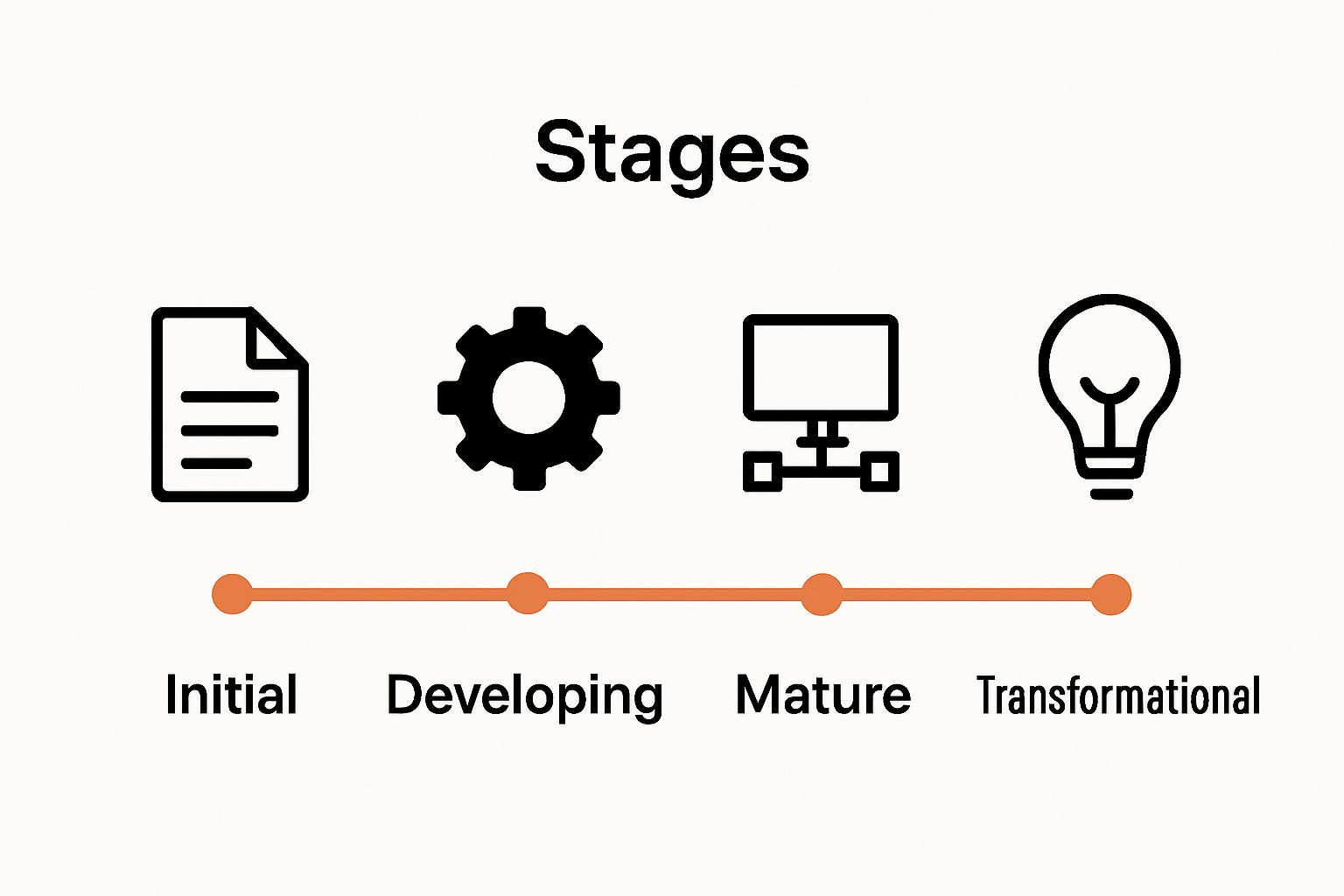09.10.25

Digital maturity is changing the insurance industry in ways few expected. More than just moving paperwork online, insurance companies with high digital maturity generate 5 times more revenue growth and 8 times more operating profit than those lagging behind. The surprise is that the biggest advantage is not the technology itself, but the deep culture shift that lets insurers rethink every part of their business from how they build products to how they handle claims.
Table of Contents
- Defining Digital Maturity In The Insurance Sector
- The Importance Of Digital Maturity For Insurance Companies
- Key Components Of Digital Maturity In Insurance
- How Digital Maturity Drives Innovation In Insurance
- Real-World Examples Of Digital Maturity In Action
Quick Summary
| Takeaway | Explanation |
|---|---|
| Digital maturity is a continuous journey | Organizations must view digital maturity as ongoing, requiring consistent learning, adaptation, and investment in technology and culture. |
| Key components drive digital maturity | Critical areas include technological infrastructure, organizational culture, data strategy, and leadership commitment, all of which work together. |
| Digital maturity enhances customer experiences | Advanced digital capabilities allow insurers to offer personalized, real-time interactions and faster claims processing, improving customer satisfaction. |
| Measure progression through defined stages | Organizations traverse stages from initial digital capabilities to a fully integrated ecosystem, indicating their level of digital sophistication. |
| Economic benefits are substantial | Companies with high digital maturity experience significantly higher revenue growth and profitability compared to less mature firms. |
Defining Digital Maturity in the Insurance Sector
Digital maturity in insurance represents a comprehensive framework that evaluates an organization’s capacity to leverage digital technologies, transform operational processes, and create strategic value through technological innovation. This concept goes beyond mere technological implementation and focuses on an integrated approach to digital transformation.
The Core Components of Digital Maturity
Understanding digital maturity requires examining multiple interconnected dimensions that collectively determine an organization’s digital readiness.
This table outlines the core components of digital maturity in the insurance sector, providing a concise overview of each element and its organizational focus.
| Component | Brief Description |
|---|---|
| Technological Infrastructure | Modern, scalable systems that enable digital adaptation and seamless integration |
| Organizational Culture | Mindset that prioritizes innovation, learning, and cross-functional collaboration |
| Data Strategy and Analytics | Approach to transforming data into actionable insights and predictive capabilities |
| Digital Leadership | Commitment of leaders to drive digital transformation and cultural change |
| Digital Skill Sets | Workforce capabilities in digital tools, data analysis, and emerging technologies |
Technological Infrastructure: At its foundation, digital maturity involves having robust, flexible, and scalable technological systems. For insurers, this means implementing modern core insurance platforms that enable rapid digital adaptation and support seamless integration across different operational domains.
Key infrastructure considerations include:
- Cloud-native architectures
- API-first design principles
- Modular and adaptable software systems
- Advanced cybersecurity frameworks
Measuring Digital Transformation Progression
Digital maturity is not a binary state but a continuum of technological and organizational evolution. Organizations progress through different stages, each characterized by increasing levels of digital sophistication, strategic alignment, and operational efficiency.
The following table summarizes the four main stages of digital maturity for insurance companies, highlighting defining characteristics at each stage to help organizations benchmark and understand their progression.
| Digital Maturity Stage | Key Characteristics |
|---|---|
| Initial | Limited digital capabilities, reliance on traditional/manual processes |
| Developing | Early digital initiatives, partial technological integration |
| Mature | Comprehensive digital strategies, significant technological alignment |
| Transformational | Fully integrated digital ecosystem, continuous innovation and advanced capabilities |

Research from Deloitte’s Digital Maturity Model suggests that insurance companies typically traverse four primary stages of digital maturity:
- Initial Stage: Limited digital capabilities, mostly traditional processes
- Developing Stage: Emerging digital initiatives with partial technological integration
- Mature Stage: Comprehensive digital strategies with significant technological alignment
- Transformational Stage: Fully integrated digital ecosystem with innovative capabilities
Successful digital maturity requires a holistic approach that balances technological investment, strategic planning, and cultural transformation. Insurers must view digital maturity not as a destination but as an ongoing journey of continuous learning and adaptation.
The Importance of Digital Maturity for Insurance Companies
Digital maturity has become a critical strategic imperative for insurance companies seeking sustainable competitive advantage in an increasingly complex and technology driven marketplace. The profound implications of digital transformation extend far beyond technological upgrades, fundamentally reshaping how insurers operate, compete, and deliver value to customers.
Strategic Competitive Advantages
Insurance companies with advanced digital maturity gain significant strategic benefits that directly impact their market performance and organizational resilience. Understanding digital-first insurance strategies reveals how technological sophistication translates into tangible business outcomes.
Key strategic advantages include:
- Enhanced operational efficiency
- Superior customer experience and engagement
- More accurate risk assessment and pricing
- Faster product development and market adaptation
Economic and Operational Impact
The economic implications of digital maturity are profound. Research from McKinsey Global Institute indicates that digitally mature organizations generate 5x more revenue growth and 8x more operating profit compared to less digitally sophisticated counterparts.
Cost Efficiency: Digital maturity enables insurers to streamline complex processes, reduce manual interventions, and optimize resource allocation. Advanced technological capabilities allow for intelligent automation, predictive analytics, and data driven decision making.
Customer Experience Transformation
Beyond internal operational improvements, digital maturity fundamentally transforms how insurance companies interact with customers. Modern consumers expect seamless, personalized, and instantaneous digital experiences that traditional insurance models struggle to deliver.
Digital mature insurers can provide:
- Omnichannel customer interactions
- Personalized insurance products
- Real time policy management
- Intuitive claims processing
Ultimately, digital maturity represents more than technological investment. It is a holistic organizational strategy that combines technological innovation, cultural adaptation, and strategic vision to create a responsive, customer centric insurance ecosystem.
Key Components of Digital Maturity in Insurance
Digital maturity in insurance is a multifaceted concept that encompasses several critical organizational dimensions. These components work synergistically to create a comprehensive digital transformation strategy that goes beyond technological implementation.
Technological Infrastructure and Capabilities
At the core of digital maturity lies a robust technological infrastructure that enables insurers to adapt, innovate, and respond quickly to market dynamics. Enhancing customer experience with digital transformation highlights the pivotal role of advanced technological capabilities.
Key technological infrastructure components include:
- Cloud computing platforms
- Advanced data analytics systems
- Artificial intelligence and machine learning capabilities
- Seamless API integration frameworks
- Cybersecurity and data protection mechanisms
Organizational Culture and Digital Leadership
Beyond technological systems, digital maturity critically depends on organizational culture and leadership commitment. Research from Gartner emphasizes that successful digital transformation requires a fundamental shift in organizational mindset and leadership approach.
Cultural Transformation: Digital mature organizations cultivate a culture that:
- Embraces continuous learning
- Promotes innovation and experimentation
- Supports cross functional collaboration
- Encourages data driven decision making
Data Strategy and Analytical Capabilities
Data represents the fundamental currency of digital maturity. Insurance companies must develop sophisticated data strategies that transform raw information into actionable insights. Advanced analytical capabilities enable insurers to predict risks, personalize products, and optimize operational processes.
Comprehensive data strategies involve:
- Comprehensive data collection mechanisms
- Advanced predictive analytics
Ultimately, digital maturity is not a destination but an ongoing journey of technological adaptation, cultural evolution, and strategic reimagination. Insurers must continuously invest in technological infrastructure, develop analytical capabilities, and nurture a culture of innovation to remain competitive in a rapidly changing digital landscape.
How Digital Maturity Drives Innovation in Insurance
Digital maturity serves as a powerful catalyst for continuous innovation in the insurance industry, transforming traditional operational models and creating unprecedented opportunities for strategic advancement. By integrating advanced technological capabilities with organizational agility, insurers can systematically drive breakthrough innovations across multiple business dimensions.
Accelerating Product Development
Digital maturity fundamentally reshapes how insurance products are conceptualized, designed, and brought to market. Drivers of digital transformation in the insurance industry underscore the critical role of technological infrastructure in enabling rapid product innovation.
Key innovation acceleration mechanisms include:
- Rapid prototyping capabilities
- Real time market feedback integration
- Modular product design frameworks
- Agile development methodologies
- Continuous customer experience optimization
Risk Assessment and Predictive Modeling
Advanced digital capabilities revolutionize risk assessment through sophisticated predictive modeling techniques. Research from Deloitte’s Insurance Trends Report highlights how data analytics and artificial intelligence transform traditional risk evaluation processes.
Technological Innovation: Digital mature insurers leverage cutting edge technologies to:
- Develop granular risk prediction models
- Implement real time risk monitoring
- Create dynamic pricing strategies
- Enable personalized risk mitigation recommendations
Ecosystem and Partnership Innovation
Digital maturity enables insurers to create expansive technological ecosystems that extend beyond traditional organizational boundaries. By developing robust integration capabilities, insurers can collaborate with technology partners, startups, and adjacent industry players to generate novel value propositions.
Ecosystem innovation strategies involve:
- Open API architectures
- Cross industry collaboration platforms
- Blockchain and distributed ledger technologies
- Seamless third party integrations
Innovation through digital maturity is not about implementing isolated technological solutions but creating a holistic, adaptive organizational approach that continuously reimagines insurance’s potential in a rapidly evolving digital landscape.
Real-World Examples of Digital Maturity in Action
Real world digital maturity demonstrates how forward thinking insurance organizations transform theoretical concepts into practical, impactful technological strategies. These examples illustrate the tangible benefits of comprehensive digital transformation across different operational domains.
Predictive Claims Processing
Munich Re’s advanced digital transformation exemplifies how insurers can leverage artificial intelligence and machine learning to revolutionize claims management. By implementing sophisticated predictive analytics, insurers can dramatically reduce processing times and improve customer satisfaction.
Key predictive claims processing innovations include:
- Automated damage assessment using computer vision
- Real time fraud detection algorithms
- Instant claims estimation technologies
- Expedited settlement workflows
- Personalized customer communication channels
Personalized Insurance Product Development
Digital mature insurers are shifting from standardized product offerings to hyper personalized insurance solutions. Advanced data analytics enable insurers to design dynamic, context aware insurance products that adapt to individual customer needs.
Research from Accenture’s Insurance Technology Trends reveals that digitally advanced insurers can:
- Create usage based insurance models
- Develop micro duration insurance products
- Implement real time risk assessment
- Generate individualized pricing strategies

Technological Ecosystem Integration
Strategic Partnerships: Digital mature insurance companies are building comprehensive technological ecosystems that extend beyond traditional organizational boundaries. These interconnected platforms enable seamless collaboration with technology providers, startups, and adjacent industry players.
Ecosystem integration strategies demonstrate how insurers can:
- Enable API driven service exchanges
- Develop platform based insurance models
- Create modular technological architectures
- Support rapid innovation cycles
These real world examples underscore digital maturity as more than a technological upgrade. It represents a fundamental reimagination of how insurance services are conceptualized, delivered, and experienced in an increasingly complex digital landscape.
Ready to Accelerate Your Digital Maturity?
Many insurers today struggle with outdated processes, disconnected core systems, and slow innovation cycles. As explored in this article, achieving true digital maturity is more than just adopting new technology—it is about building seamless, integrated workflows and creating a customer-centric digital ecosystem. A lack of robust technological infrastructure or the inability to adapt quickly to market changes can leave your business behind and unable to meet rising customer expectations.
IBSuite by Insurance Business Applications (IBA) empowers you to solve these pain points. Our cloud-native, API-first core insurance platform covers every aspect of the insurance value chain, from sales and claims to billing and compliance. IBSuite supports rapid product launches, personalized experiences, and agile responses to evolving market needs. Want to see how you can transform your insurance operations and build lasting resilience? Book a demo with IBA today and take the first step toward sustainable digital maturity. Do not wait—discover how an end-to-end solution built for the modern insurer can put you ahead now.
Frequently Asked Questions
What is digital maturity in the insurance sector?
Digital maturity in the insurance sector refers to an organization’s ability to leverage digital technologies to improve operational processes, drive innovation, and create strategic value. It encompasses various aspects like technological infrastructure, organizational culture, data capabilities, and digital skills.
How can insurance companies measure their digital maturity?
Insurance companies can measure their digital maturity by assessing their progression through different stages, such as initial, developing, mature, and transformational stages. Each stage represents varying levels of technological integration and operational efficiency.
What are the key components of digital maturity in insurance?
Key components include technological infrastructure (like cloud computing and data analytics), organizational culture (emphasizing innovation and collaboration), and a robust data strategy that turns raw data into actionable insights.
How does digital maturity impact customer experience in insurance?
Digital maturity significantly enhances customer experience by enabling insurers to provide personalized insurance products, seamless omnichannel interactions, real-time policy management, and intuitive claims processing.
Recommended
- Drivers of Digital Transformation in the Insurance Industry – Digital Insurance Platform | IBSuite Insurance Software | Modern Insurance System
- Understanding Digital-First Insurance Strategies – Digital Insurance Platform | IBSuite Insurance Software | Modern Insurance System
- The Top 5 Challenges Facing the Insurance Industry Today – Digital Insurance Platform | IBSuite Insurance Software | Modern Insurance System
- Enhancing Customer Experience with Digital Transformation – Digital Insurance Platform | IBSuite Insurance Software | Modern Insurance System